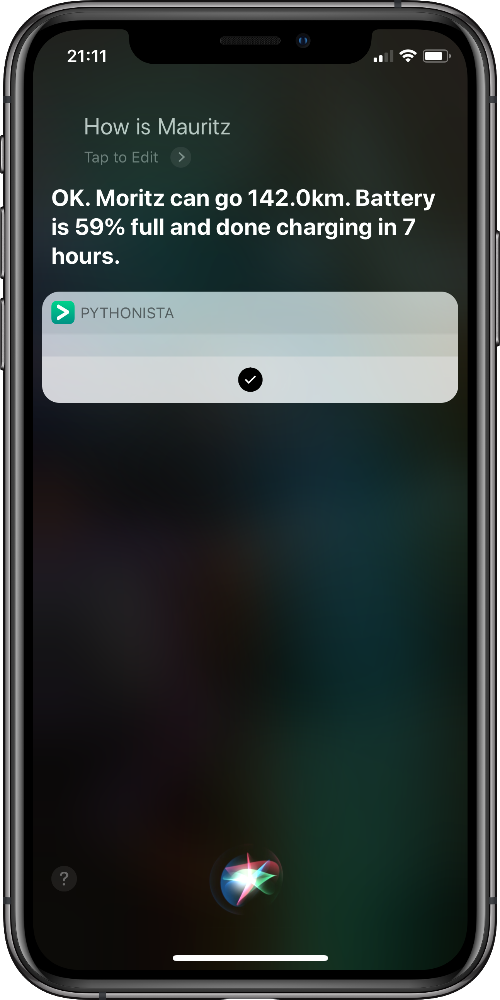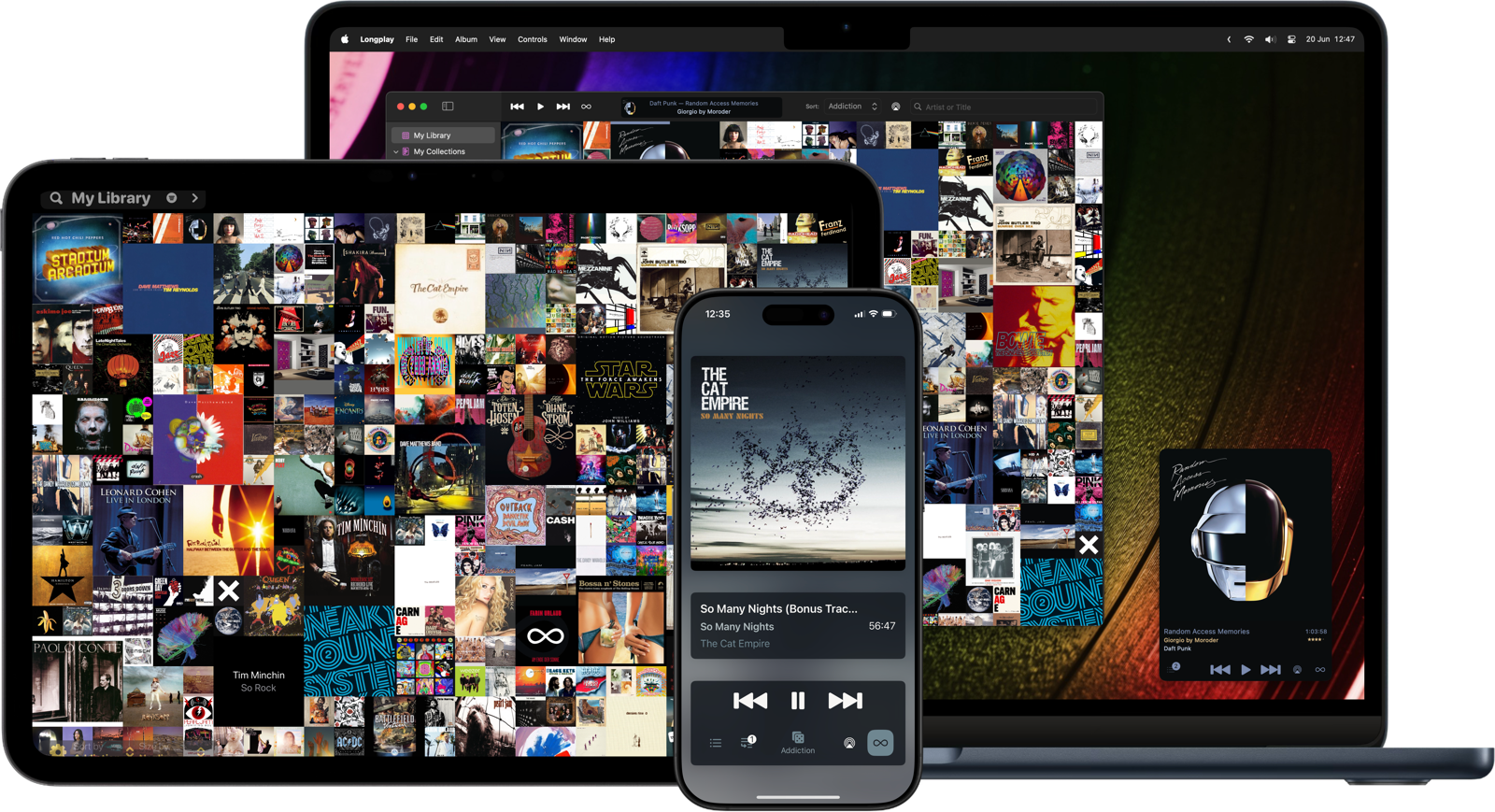Posts
-
Capability
I love the take from Valve engineers on their philosophy for the Steam devices:
We don’t block anyone from doing what they want to with their device. […] This is your device, your computer, you own it, you can mod it and extend it in any way.
more… -
Longplay comes to the Mac
I am thrilled to be finally releasing Longplay for Mac today. Longplay is all about the joy of listening to entire albums and marvelling at their beautiful album artwork. It is built from the ground up for the Mac, with the familiar pretty album wall, a dedicated mini player, all the main features from iOS, plus Mac exclusives like AppleScript and a nifty MCP server. I love how it turned out. For all the details, check out longplay.rocks, where you can download the app to try yourself — you need to unlock to listen though — , or find it on the Mac App Store. Read on for a bit of my developer’s commentary of this release. more…
-
Upgrading to a 2024 iPad Air from a 2018 iPad Pro
My 2018 12.9 iPad Pro has been one of my greatest tech purchases. I’ve used it nearly every day for the last 5.5 years, and it’s still in great shape. Why upgrade now? While I’m not an artist, I love my Apple Pencil for taking notes, sketching my thoughts, and drawing; andwhen I tried the Apple Pencil Pro in a store the other day, I really liked the new squeeze feature and how it makes the tool palette much quicker to access and my old iPad Pro never got the support for the pencil hover, so the combo made me keen to upgrade. more…
-
Apple's Intelligence
Apple Intelligence is a compelling privacy-first take on generative AI. Unfortunately, it’s not accessible to third-party developers. As Manton Reece points out on Core Intuition #603 more…
-
Installing a macOS Beta in a Separate APFS Volume
It’s beta season for Apple developers, but it’s not a wise idea to install those betas on your main machines. Dual boot is the way. This way, you can easily switch back to your stable version of macOS if needed. I did not find an up-to-date guide to install a macOS beta in a separate APFS volume on your Mac. more…
-
Introducing Longplay 2.0
I’m excited to launch a big 2.0 update to my album-focussed music player, Longplay. If you’re interested in the app itself and what’s new, head over to longplay.rocks or the App Store. In this post I want to share some of the story behind the update. more…
-
Insights from Microsoft Build for app developers
It’s conference season for developers and Microsoft’s annual conference Build just wrapped up. I haven’t paid particular attention to Build in the past, but it’s been interesting to follow this year due to Microsoft’s close collaboration with OpenAI and them pushing ahead with integrating generative AI across the board. My primary interest is in what tools they provide to developers and what overarching paradigms they – and OpenAI – are pushing. The key phrase was Copilots, which can be summarised as “AI assistants” that help you with complex cognitive tasks, and specially do not do these tasks fully by themselves. Microsoft repeatedly pointed out the various limitations of Large Language Models (LLMs) and how to work within these limitations when building applications. Microsoft presented a suite of tools under the Azure AI umbrella to help developers build these applications, leverage the power of OpenAI’s models (as well as other models), and do so in manner where your data stays private and secure, and is not used to train other models. more…
-
State of AI, May 2023
Discussions about dangers keep heating up more…
-
The essence of an app
Horace Dediu has a way of putting things into an insightful perspective that makes you look at things differently. In the latest Critical Path episode, he points out that what people enjoyed about the iPod (and the Walkman before) wasn’t just that it let’s you take your music with you, but that it gives you privacy in a public space. Similarly, the product of a gym is not just exercise, but delivering a feeling of guilt. It’s a way of looking at a thing beyond it’s features and immediate use case. more…
-
Introducing Longplay
Longplay, my first self-published iOS app, is now available on the App Store. I’m super excited.
 more…
more… -
Framework Sherlocking at WWDC 2019
WWDC is lovingly referred to as “Christmas for Apple Developers” and, goodness, was it a Bescherung this year! Apple has been hitting it out of the park at this year’s WWDC. While in the past many developers have been worried that their apps were getting replaced with Apple’s own new or improved apps (aka “Sherlocking”), a big surprise of this year is how many third-party libraries and tools now have first-party replacements1
more…- These are only the ones that I’m familiar with and that stood out to me in the subset of videos that I watched. There’s likely even more. ↩
-
Next steps for Siri, and other WWDC 2019 wishes
Apple’s annual developer conference, WWDC, is just around the corner. As a developer of iOS apps and heavy user of macOS, this is always an exciting time of the year. There is talk about iOS apps being able to run on macOS and dark mode coming to iOS. Before I get busy with implementing these from next week on, it’s fun to take a step back and think about what I would like to see Apple do and let developers do. I’ll start with my hopes for Siri, and then more wishes from a more (power) user perspective and then from a developer perspective. more…
-
Hey Siri, pre-heat my car
 When I got my Renault Zoe, I was excited to see that it came with an accompanying app, which let’s you remotely pre-heat (or cool) the car and also check the charge status of the battery. Being able to pre-condition the car is great as the process takes a few minutes and it’s nice when it’s finished by the time you’re getting into the car. And having remote access to the charging status is especially handy on road trips: Firstly, it’s annoying to go back to the car and find that it still needs to charge for another half hour and you could have gotten a coffee or went for a nice walk. Secondly, you might be wasting money by remaining plugged in when the car is already full, if you’re getting charged by the minute. So there’s real utility to such an app.
more…
When I got my Renault Zoe, I was excited to see that it came with an accompanying app, which let’s you remotely pre-heat (or cool) the car and also check the charge status of the battery. Being able to pre-condition the car is great as the process takes a few minutes and it’s nice when it’s finished by the time you’re getting into the car. And having remote access to the charging status is especially handy on road trips: Firstly, it’s annoying to go back to the car and find that it still needs to charge for another half hour and you could have gotten a coffee or went for a nice walk. Secondly, you might be wasting money by remaining plugged in when the car is already full, if you’re getting charged by the minute. So there’s real utility to such an app.
more… -
Switching Mojave's dark and light themes using touch bar
Mac OS Mojave introduces both a pretty dark mode and a way to trigger Automator scripts right from the Touch Bar. more…
-
iPad Pro 12.9 vs. 10.5
The iPad Pro is a great device and I’ve been happily using the 12.9 inch model for a good 1.5 years. At times it felt too large though – especially when using it on the couch. So when I got the chance to get a new iPad for work, I decided to give the 10.5 inch model a try. What follows are my observations after a few months of using the 10.5 inch model running iOS 11. more…
-
Google does not get privacy
Sundar Pichai, CEO of Google, in an interview with Walt Mossberg at Recode’s Code Conference 2016 1:
We want you to be able to tell Google: maybe the last four hours, just take it off and go off the record. […] you can switch on in-cognito mode. […] I want to save every conversation that I have with my daughter for eternity […]; but some other converations, […] maybe with my general council at Google, I want to be private.
Google has a binary view on privacy. Things are either on the record or off the record—with the default being the former. more… -
Secure your mails
Ever read a post card that wasn’t meant for you? Without encryption, emails you send and receive are as easy to read as post cards. They could barely have less security, as they are transmitted in plain text. This means that any computer between yours and the recipient’s can study the mails in full without much effort. Encryption prevents your email provider (e.g. Google or Yahoo) from seeing and analysing your email content. more…

